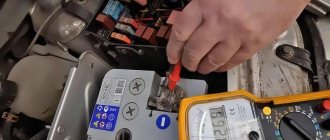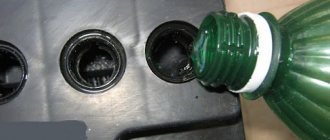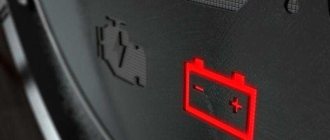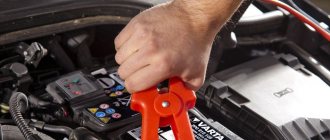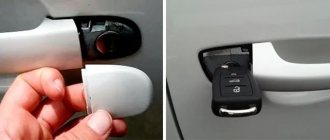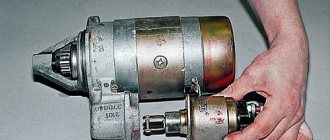In the winter season, the following misfortune may happen to the battery. After a cold night, you can come to your car and find that the electrolyte in the battery banks has frozen. This cannot be said to be a mass phenomenon, but in northern latitudes it happens quite often. Such messages can often be found on automotive forums. Moreover, this can happen with both an old and a new battery. What is the reason for this phenomenon and how to avoid it?
Why does the car battery freeze?
As you know, the electrolyte is a mixture of sulfuric acid and distilled water. The density of the electrolyte sold online is 1.27 – 1.28 g/cm3. With such density indicators, the liquid will freeze at a temperature of about minus 70 degrees.
Therefore, if no serious violations were committed during the preparation of the electrolyte, then you can safely use the battery even during severe frost. Ice formation in the battery case can occur as a result of a strong decrease in this indicator.
A drop in the electrolyte density in the battery can occur for the following reasons:
- With frequent addition of distilled water.
- Heavy battery drain.
In the first case, the decrease in electrolyte density can occur with varying intensity. If the electrolyte level decreases due to evaporation, then by adding distilled liquid it is possible to almost completely restore the original density value. If this operation has to be performed as a result of depressurization of the battery or splashing of the water-acid mixture, then adding water will lead to a significant decrease in the density of the electrolyte.
A severe discharge of the battery is possible not only under heavy load from a large number of electrical appliances, but also when the car is idle. Even a new battery, at rest, discharges at a rate of at least 0.1% per day, and old batteries can be completely discharged in this way within 1 - 2 weeks. Especially if it's cold outside.
What does the battery consist of?
I’ve talked about it a thousand times already on the blog (for those who want to educate themselves, read the article - how a battery works , it’s really laid out “at your fingertips”). BUT I will repeat, briefly, to understand the map of the incident. The main elements are:
Housing - made of six sealed compartments (usually made of plastic so that it does not react with acid).
The plates are negative and positive (made of lead and its dioxide, respectively).
Electrolyte is a special conductive liquid made from sulfuric acid + distilled water . Without it, the battery would not work.
The plates are immersed in a housing and filled with electrolyte, which is exactly what a regular lead-acid battery is. The more lead and liquid inside, the larger its capacity.
Got it, let's move on.
At what temperature does the battery freeze?
If the battery is 100% charged, the electrolyte will not freeze in the cold. When using a serviceable battery model, you can use a hydrometer to accurately determine the freezing temperature of the battery.
The ratio of electrolyte density to freezing temperature is approximately as follows:
Battery electrolyte freezing table
| Electrolyte density (g/cm3) | No-load voltage (V) | Voltage with load (V) | Charge level (%) | Electrolyte freezing (C) |
| 1,27 | 12,66 | 10,8 | 100 | -60 |
| 1,26 | 12,6 | 10,66 | 94 | -55 |
| 1,25 | 12,54 | 10,5 | 87,5 | -50 |
| 1,24 | 12,48 | 10,34 | 81 | -46 |
| 1,23 | 12,42 | 10,2 | 75 | -42 |
| 1,22 | 12,36 | 10,06 | 69 | -37 |
| 1,21 | 12,3 | 9,9 | 62,5 | -32 |
| 1,2 | 12,24 | 9,74 | 56 | -27 |
| 1,19 | 12,18 | 9,6 | 50 | -24 |
| 1,18 | 12,12 | 9,46 | 44 | -18 |
| 1,17 | 12,06 | 9,3 | 37,5 | -16 |
| 1,16 | 12 | 9,14 | 31 | -14 |
| 1,15 | 11,94 | 9 | 25 | -13 |
| 1,14 | 11,88 | 8,84 | 19 | -11 |
| 1,13 | 11,82 | 8,68 | 12,56 | -9 |
| 1,12 | 11,76 | 8,54 | 6 | -8 |
| 1,11 | 11,7 | 8,4 | 0,0 | -7 |
A fully charged battery can easily withstand temperatures of minus 70 degrees, so even when operating a car in the northern regions of the country, you don’t have to insulate the battery, as long as you recharge the battery in a timely manner.
Important! If you drive short distances in cold weather, the battery does not have time to fully warm up and charge, which means that after several such trips you will need to recharge the battery.
What should I do to prevent the battery from freezing?
You probably already guessed, but I’ll repeat it again:
- We do not allow deep discharges of the battery, this is especially important in winter during severe frosts. It is for this reason that the electrolyte freezes.
- We check all electrical systems of the car for leaks, this is critical in winter.
- If you leave the car for a long time, 2 - 3 months in the cold, then it is better to remove one terminal (preferably the negative one), the leakage currents will drop to zero, so the battery will remain charged longer.
- Remember in winter, electricity consumption, including from the battery, is much higher. This is due to cold engine starts, heated seats, mirrors, windows and even windshield wipers, frequent use of the stove (at high speeds), due to the fact that it gets dark earlier we have to turn on the headlights earlier. In order for your battery to serve you longer (in winter) - recharge it; if you don’t have a “charger”, then at least on weekends arrange trips for 30-40 minutes, the generator will provide the energy that is missing. And then the electrolyte will almost never freeze.
These are the simple recommendations, I think it’s now clear what to do and where to run when the battery of your precious car is frozen.
Now there is a video version, just about complex things, watch.
I’ll finish this, I think this information was useful to you.
Similar news
- Batteries “Europe” and “Asia” - what are they? How to determine and what they...
- Battery bank. What it is? How many are there? What is the voltage
- Gel or acid battery. Which is better? Only facts + B...
Add a comment Cancel reply
What can electrolyte freeze up cause?
When the electrolyte freezes, a significant increase in its volume occurs, which, in conditions of limited internal space of the battery, can lead to mechanical destruction of the plastic shell.
Excessive ice pressure on the electrodes also has a destructive effect, which manifests itself in the form of warping of the metal and shedding of the active mass to the bottom of the battery. It should be noted that the negative consequences of electrolyte freezing are not always limited to battery failure.
If a frozen battery was in a car, and its case was damaged as a result of ice formation, then after thawing and flowing out of the case, the caustic liquid will damage metal parts located in the immediate vicinity.
Important! For a battery, the negative consequences of complete freezing of the electrolyte may not be as dangerous as incorrect actions to restore its functionality.
Gray or black electrolyte is bad!
Let's say you defrosted the battery, but when you looked at the cans (battery compartments), it or two took on a black or thick gray color. I want to say right away, go get a new battery, what does this tell us, but nothing good:
When the water froze, it damaged the lead plates and simply destroyed them, or, if you like, tore them. After the electrolyte has defrosted and turned back into liquid, these compartments no longer have structured plates, but simply a bunch of lead that was mixed in the jar, which is why it became cloudy. Even if one bank fails, the voltage will drop by 2 Volts, that is, the nominal value will be 12 and 10 Volts. Such a battery will not be able to start your car, and what can it start, it is not even able to “soak” the car’s systems (radio, ECU, dashboard, etc.). This is the “death” of the battery.
Of course, many manage to restore this jar by cutting the top and pulling out - restoring the package of lead plates. But for an ordinary car enthusiast, this is very difficult and almost impossible. Let's go get a new battery.
What to do if the battery in your car is frozen
If the battery is frozen in the car, then it should be disconnected from the contact wires and the case should be carefully inspected. If the inspection reveals through cracks, it will not be possible to revive the battery.
If freezing of the electrolyte does not lead to depressurization of the battery, then it must be brought into a heated room. It is strictly forbidden to charge the battery immediately, otherwise the plates are guaranteed to be damaged. To eliminate the possibility of electrolyte leakage, if microcracks were not noticed during the inspection of the battery, it is recommended to install the battery for defrosting in any plastic container of suitable volume.
When the ice inside the battery melts, the battery is set to charge with a current of 10% of its capacity. The battery must be charged within 10 hours.
Battery failure may occur even if one bank is frozen, so during the initial inspection, as well as before restoring the charge level after defrosting, it is recommended to make sure that the ice inside the battery case has completely melted.
We recommend reading on the topic: How to warm up a battery.
Battery resuscitation
The battery is a rather capricious device. With proper care, the power supply will easily last 3-5 years without causing any complaints. But different things happen.
Having noticed that ice has formed on the case and the electrolyte has frozen, the first thing they do is remove the battery from the socket, disconnecting it from the contacts. Then they are taken to a warm room and placed in a suitable container, for example, a basin. Why this is done: if the housing is damaged due to freezing and a microcrack has formed, electrolyte will flow from it. It will not be possible to operate a battery without “chemistry”, that is, resuscitation will not bring results.
Battery reanimation process.
If nothing leaks, you should wait until the battery and electrolyte warm up to room temperature. You cannot immediately charge a frozen car battery - you need to evaluate the condition of the case again. If cracks and unevenness are still noticeable, just dispose of such a battery. Some will say that small cracks can be easily repaired with the same mastic, but the point is different. The power supply froze so hard that its casing began to collapse. If it came to this, then the metal plates had definitely deteriorated.
In those “banks” where the plates are warped, a short circuit is likely to occur. If the separator separating the polarities is damaged, a short circuit cannot be avoided. It can be eliminated, but it takes a lot of time and effort.
If no visual damage is detected, all that remains is to wait until it has completely thawed and charge it with a charger. The current strength is set to 10% of the actual energy intensity. A full charge will take about 10 hours. At the end, measure the voltage at the battery terminals. The minimum should show 12.6 V. If the number is, for example, 10.5 V, then one of the “cans” has gone bad (the parameter for one element is 2.1 V). Measuring the density of each can will help you find the “outdated” one. For this you need a hydrometer.
If, after the charge is restored, the density of each element is at the level of 1.27 g/cm3, and the voltage is within 12.6 - 12.9 V, then the “freezing” did not lead to negative consequences, and the battery will still work. The only thing is that in winter it is recommended to slightly increase the density, up to 1.3 g/cm3.
What is an electrolyte
This is the working fluid in traditional batteries, both serviced and sealed. Consists of a solution of distilled water and acid or alkali. In addition, the batteries themselves from different manufacturers differ significantly in the composition of the active grids inside the case. You can find out whether each battery contains alkali or acid from the product passport, which is issued along with this product.
The most common type of battery used is sulfuric acid. The density of the electrolyte is determined by the concentration (amount) of acid in the solution, the ambient temperature and the degree of charge of the battery.
When servicing the battery, it is sometimes necessary to top up with distilled water. After several such operations, the density can decrease significantly (little acid - a lot of water).
How to take care of your battery in winter.
Cold weather negatively affects all vehicle systems. But the winter period causes more damage to the car battery. Fortunately, by following simple tips, every car enthusiast can keep a car battery in good condition and increase its service life.
Rechargeable batteries, like people, like to be warm in the winter and to have enough energy supplied due to the power supply, which, like a person, gives a charge. This is why in winter we need more nutrition, since in the cold we spend more energy than in summer. The same story applies to any rechargeable batteries.
At what temperature does the electrolyte freeze?
| Density at 25°C, g/cm³ | Freezing, °C | Density at 25°C, g/cm³ | Freezing, °C |
| 1,09 | -7 | 1,22 | -40 |
| 1,10 | -8 | 1,23 | -42 |
| 1,11 | -9 | 1,24 | -50 |
| 1,12 | -10 | 1,25 | -54 |
| 1,13 | -12 | 1,26 | -58 |
| 1,14 | -14 | 1,27 | -68 |
| 1,15 | -16 | 1,28 | -74 |
| 1,16 | -18 | 1,29 | -68 |
| 1,17 | -20 | 1,30 | -66 |
| 1,18 | -22 | 1,31 | -64 |
| 1,19 | -25 | 1,32 | -57 |
| 1,20 | -28 | 1,33 | -54 |
| 1,21 | -34 | 1,40 | -37 |
A car battery likes to be constantly charged. This is why if you have been using the car for a long time, the battery may lose its charge. It is noteworthy that discharge can occur not only in cold weather in winter. But in winter, a problem with the battery may be due to the freezing of the electrolyte, which froze due to insufficient density of the liquid in the battery.
What can cause the electrolyte density to decrease?
There are a huge number of reasons why the density of the electrolyte in a battery can decrease or increase, ranging from the condition of the plates and jumpers in the battery to problems with the generator, which produces either insufficient charging current or is overcharging.


